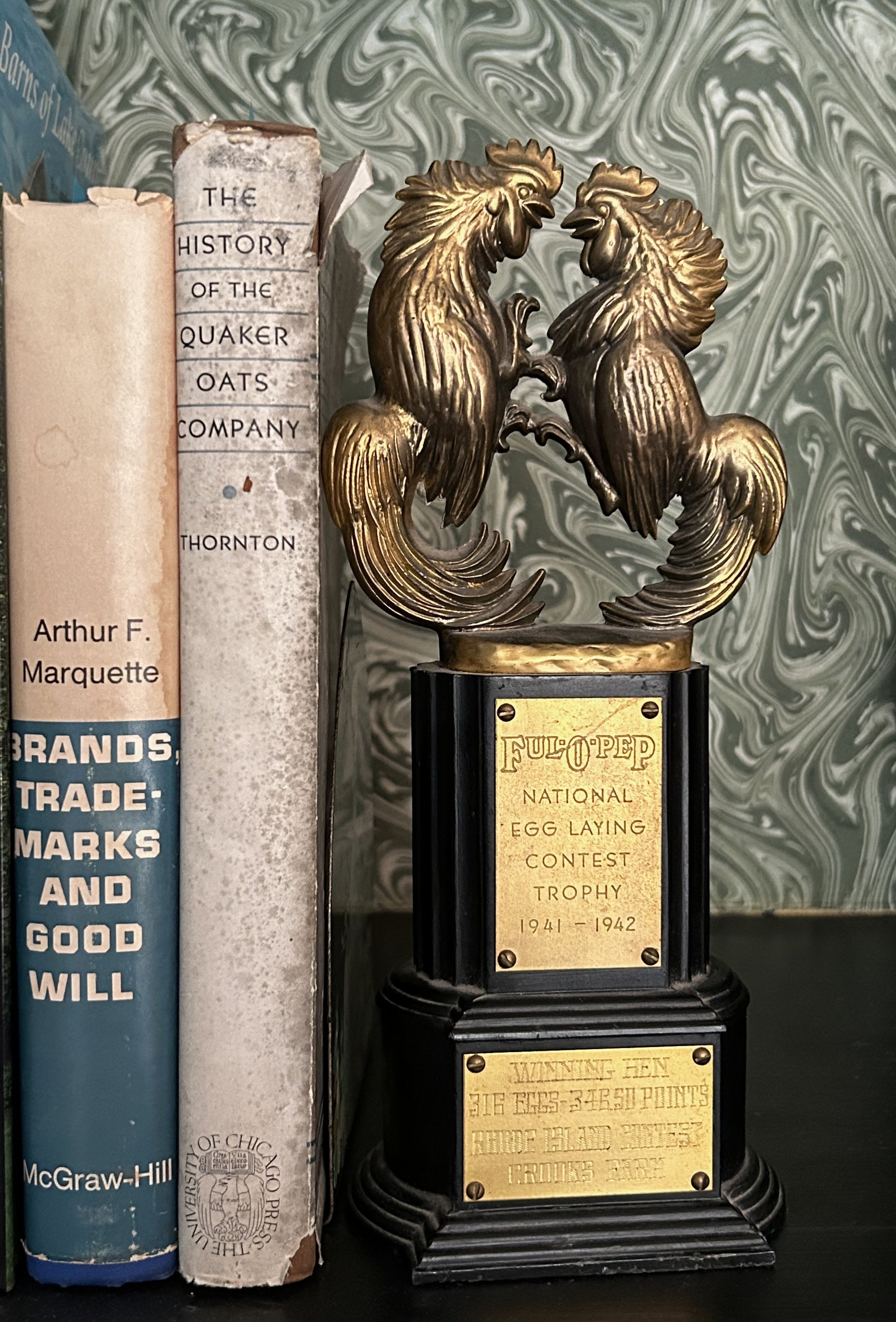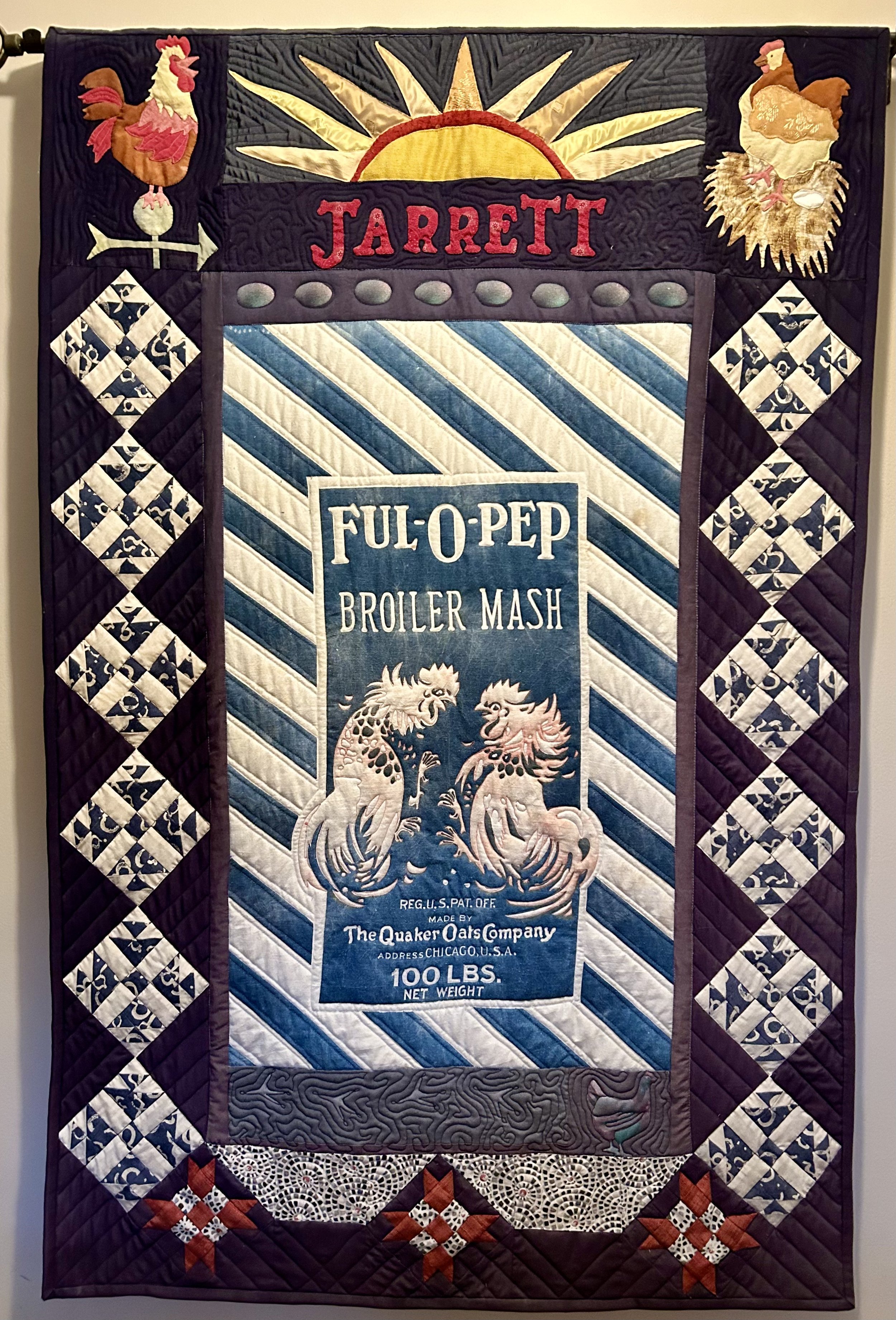Ful-O-Pep Roosters
Sometimes historic artifacts are hard to reconcile with our modern sensibilities. Recognizing the misguided ideas of earlier generations can help us accept artifacts we might flinch at otherwise. This trophy of two cocks fighting, from our property’s history, is one such item. Quaker Oats began a chicken feed business in the early 1920s, and, with the attitudes of that era, felt this was an appropriate logo for their new “Ful-O-Pep” business. The assumption being the roosters were feisty and thus full of pep? It is definitely not a fabulous logo from our modern perspective, but, unfortunately for us, it is pretty much on all the artifacts related to our historic home.
A quick history: in the 1920s Quaker Oats wanted to find a way to market the byproducts created in the manufacturing of oatmeal, instead of throwing it in waterways. While I applaud the desire to keep junk out of the water, I suspect the idea was driven more by profits than ecology. The company hired Onley Brown Kent, the first veterinarian with a degree in “chicken husbandry” from Cornell University (I kid you not). Quaker Oats then purchased a farm with 65 acres, a huge wood barn and two houses in 1922 in rural Libertyville. The farm ran for 43 years as a research facility, testing the fortified oat poultry feed and housing over 2,000 chickens. The success of the feed was based on the production of egg laying, and was marketed to mom and pop farmers with backyard chicken coops. The big barn was the warehouse, and the company shipped feed bags of product across the country to feed stores, all with a version of the Ful-O-Pep rooster logo emblazed on them. I have a number of these feed sacks, and even found one inside the wall of the kitchen when we renovated it years back.
I was surprised to learn that as recently as 2007 cock fighting was still legal in parts of the United States. Louisiana was the last state to finally ban it that year, and by 2018 the federal government banned all animal fighting – including cockfights – in all states and territories, as well as making it a crime to “knowingly sell, buy, possess, train, transport, deliver or receive any chicken across state lines for fighting purposes.” (1) Apparently, the “blood sport” remains popular – and financially lucrative – in many countries, and Puerto Rico petitioned all the way to the U.S. Supreme Court in 2022 to allow cockfights in the territory. The case was dismissed, and our federal ban remains. I also had no idea that “George Washington and Thomas Jefferson were devoted rooster fighters. Union and Confederate soldiers put aside their differences on Sundays during the Civil War to pit their chickens against one another. Abraham Lincoln was given the nickname Honest Abe after he displayed impartiality as a cockfighting judge.” (1) I am thankful that the idea of fighting roosters is no longer acceptable, for the roosters’ sake. And I try to enjoy the history of our property regardless of the dreadful logo.
When we first purchased what is left of the farm (after it was subdivided in the 1980s), eBay was a great source for finding vintage Ful-o-Pep items, including the books in the photograph. One eBay dealer back in 2001 sold me a very large metal “Ful-O-Pep Feed” advertising sign we wanted to mount on a barn. The woman, from Kentucky, commented that she thought the sign would be great for someone running cock fights, and wondered if I did. Dear lord. Amusingly, soon after I hung the sign, a rather dilapidated minivan pulled into our long driveway. Two older women got out and asked me where “the feed store” was – they saw the sign and thought they could pick up their animal feed here in town! Many of the items I acquired are displayed on the property, and the feed bags, with their fighting roosters logo, have been incorporated into quilts.
The trophy was acquired from eBay, and sits on our bookshelves. It is an award from 1942 for the “National Egg Laying Contest”, and was given to the best laying hen (316 eggs) from Rhode Island. I am assuming that the hen was raised on Ful-O-Pep feed, though the poor girl was not identified. Crooks Farm took home the trophy, however it seems “Rhode Island Red” chickens are famous for being “good layers”, laying upwards of 300 eggs a year, as compared to the more typical 250. Am I the only one that thinks the logo of fighting roosters an odd choice for a company focused on the egg laying success of their chicken feed? Last I checked, the girls do all the work…
(1) https://www.nytimes.com/2023/01/18/magazine/cockfighting-rooster-breeding.html


